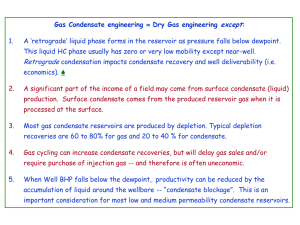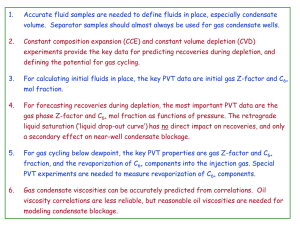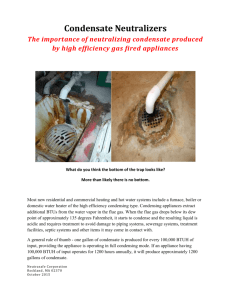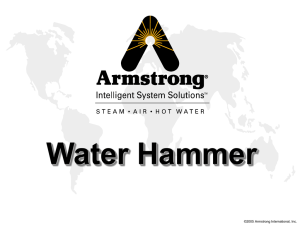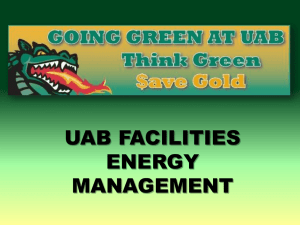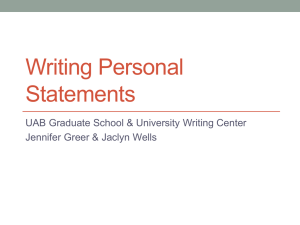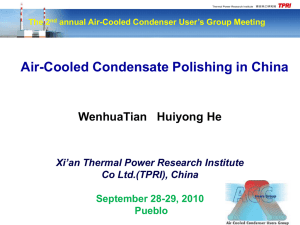Case Study Of Condensate Recovery And Its Reuse at The
advertisement
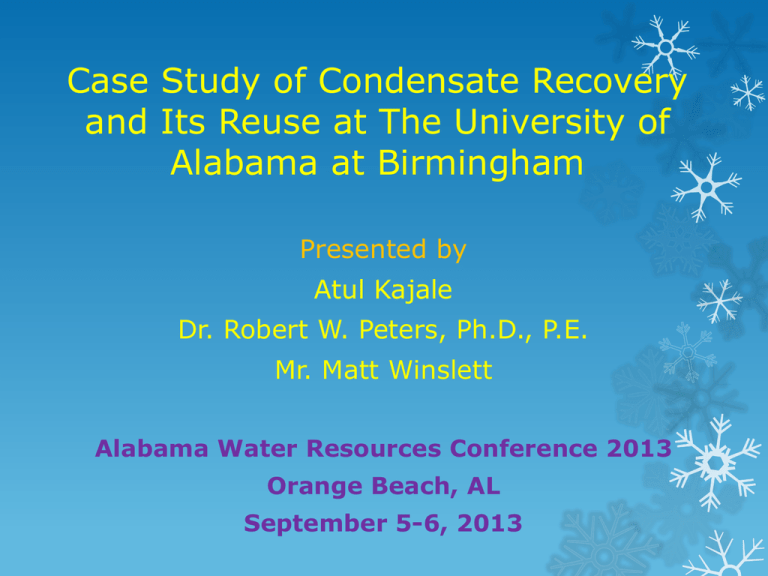
Case Study of Condensate Recovery and Its Reuse at The University of Alabama at Birmingham Presented by Atul Kajale Dr. Robert W. Peters, Ph.D., P.E. Mr. Matt Winslett Alabama Water Resources Conference 2013 Orange Beach, AL September 5-6, 2013 Overview 1. Introduction 2. Condensate recovery 3. Chilled water usage 4. Results 5. Discussion and Conclusions Introduction Condensate Recovery: Recovery of the condensate water produced from the air handling units (AHUs) and its reuse in processes where non-potable water is required. Condensate Recovery Systems (CRS) in new constructions and in existing buildings. Uses of condensate water- for irrigation, flushing toilets, reuse in chilled water plants Southeastern states have potential of capturing more than 15 gallons per cfm of air [Lawrence and Perry, 2010]. Introduction Research done in co-operation with the Energy Management Division of the Facilities Management Department at the University of Alabama at Birmingham (UAB) CRSs in seven campus buildings Laboratories, and research buildings use- 100% outside air Pipes, joints/connectors, water storage tanks (100-500 gallons), pumps, floating devices, filters, and water - meters. Condensate Recovery Figure 1. Condensate Collection Potential in United States. [Lawrence and Perry, (2010)] Drought Condition August, 2012 December, 2012 August, 2013 Condensate Recovery at UAB Figure 2. Schematic of the Condensate Collection System at UAB. Condensate Recovery at UAB Figure 3. Condensate Recovery System at UAB: Small storage tank, 500-gallon storage tank Condensate Recovery at UAB Condensate from each 500-gallon storage tanks is measured by a water - meter Condensate production in 4 AHUs is continuously monitored and recorded in real-time using HOBOU20 water level dataloggers Change in water level, temperature, and pressure. Condensate is fed to the chilled water return pipe Temperature of condensate (53⁰F-73⁰F) Condensate Recovery at UAB Main objectives of the study: Develop a multiple regression model to analyze the effect of indoor and outdoor operating conditions. Model validation, hypothesis testing Sensitivity analysis and uncertainty analysis Projection for other campus buildings Feasibility analysis and applicability for other locations in Alabama. Condensate Recovery at UAB Building Name Installation Cost McCallum Building $ 25,000 Kaul Building $ 16,000 Zeigler Building $ 5,500 Tinsley Harrison Tower $ 2,500 Bevill Building $ 30,000 Resreach Support Building $ 25,500 Volker Hall Tower $ 24,000 Wallace Tumor Institute $ 20,000 Total $ 150,000 Table 1. Detailed Cost of Condensate Recovery System at UAB Results 3 chilled water plants serve 52 campus buildings. Make-up water demand and cost Figure 4. Water demand of UAB Central Chilled Water Plant Results Year Water in gallons Figure 5. Condensate volume 2012 (12 months) 3,232,962 recovered at McCallum and Tinsley Harrison Tower 2013 (7 months) 2,128,719 Results Figure 6. Condensate volume recovered from six condensate recovery systems Results In 2011, total water demand was 311,00 CCF and the cost $2,170,000. In 2012, total water demand was 310,199 CCF and the cost $1,960,075. More than 7 million gallons of water was captured and reused in 2012. 5.7 million gallons of condensate is captured in 2013 till the end of July. 12.7 millions gallons accounts for $54,500. This accounts for 5% of water demand and 2.7% of associated cost Results The peak condensate recovery during summer was 4.38 gph/1000 ft2. Average condensate was is 6 times higher than predicted by Guz’s study (2005). The minimum and maximum hourly condensate volumes ranged from 0 to 230 gph. 12.7 millions gallons of condensate recovery accounts for $54,500 of savings. Average payback period of 3 years for the entire project. Discussion Advantages of reuse of condensate water in chilled water plants: Lowers the water demand of the chilled water plant. Efficient use of potable water. Temperature of condensate varies between 53 ⁰F and 74 ⁰F whereas the temperature of municipal water is 81 ⁰F. Feasibility: water savings, energy savings, and sewer cost Discussion Majority of the southeastern United States is prone to drought condition and hence conservation of water is very important. Hot and humid weather is favorable for successful condensate recovery. There is great potential for water conservation in commercial, industrial, and institutional buildings. CRS at UAB have shown significant collection of condensate Indicating opportunity to install more systems across the campus buildings. Acknowledgement Energy Management Division of Facilities Management Department at UAB Sigma Xi Scientific Research Society Department of Civil, Construction, and Environmental Engineering at University of Alabama at Birmingham Thank You!!!
